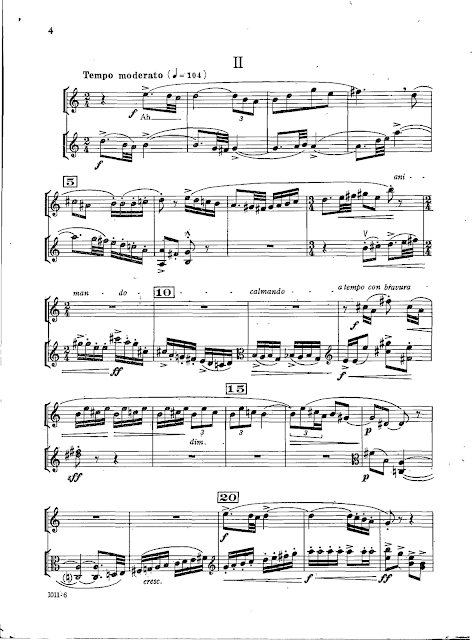I'm pleased as punch to announce that Cursive, my modern chamber group specializing in performing the kind of unknown modern music that gets featured on this blog, has a new program, Imagist Alchemy, coming up this Thursday, October 6, at 7:30 pm at Kenyon Hall, West Seattle's greatest old-timey theater. The program will feature works for different combinations of voice, flute, viola and cello by mid-century American composers inspired by the Imagist poetry movement of the first half of the 20th century. The composers include the likes of David Diamond, Adolph Weiss, Paul Pisk and Ben Weber, and Re-Composing is finally going to put the spotlight on these forgotten (some more than others) composers in the days leading up to Imagist Alchemy's big show. I can't say I'll be able to cover all of them but there's still plenty to talk about, starting with a warm return to one of the former biggest stars in American music, David Diamond.
I previously covered Diamond's haunting piano miniature The Tomb of Melville, and hopefully I made a case for it being one of the most beguilingly lovely piano pieces in American music. It's absence from modern recitals, or recitals in general, is only partially understandable by its limbo state of out-of-printdom, as Diamond used to be as big a name as Schuman, Harris and Piston. Best known for his string orchestra piece Rounds, Diamond's signature works show off one of the most skilled and assured voices in the big American national style of the '40's and '50's - modal block chords, expert counterpoint and lots of 'Merican 'tude. That doesn't mean that all of his works sound the same of course, and for maximum Diamond variety one should turn to his later works ('60's and forward) and his earliest works from the '30's, such as his ballet TOM. These early years are what we're examining today with one of his first works, soon to be featured by Cursive in Imagist Alchemy: Vocalises for voice and viola.
Voice and viola works are elusive and alluring beasts, possessing a warmth and darkness because of the instrumentation but never getting performed. This piece is a trio of vocalises, so the voice sings on an open syllable, allowing itself to weave through the viola's copious double stops with a snake-like silkiness. Diamond was only 20 when he wrote this, meaning that he was under the tutelage of Nadia Boulanger, American music's favorite French auntie, and it's very easy to see the Old World influence in this piece. It's not just Francophonic, either, but vaguely Renaissance, the lilting melodies and stark chord progressions highly reminiscent of an Old Master landscape. One could also point to Christina's World, one of the most famous paintings in the whole world, and I'd like to think that Old World and New World landscapes aren't mutually exclusive. The version we're playing is slightly modified to accommodate a flute, but don't let that deter you, as flute and viola are a fascinating combo in themselves and the musicians are much boss. Here's a splendid recording of the original that really brings out the bucolic solitude of the piece, and here's to wishing all my readers a happy time checking their schedules to see if they can make the concert.
I previously covered Diamond's haunting piano miniature The Tomb of Melville, and hopefully I made a case for it being one of the most beguilingly lovely piano pieces in American music. It's absence from modern recitals, or recitals in general, is only partially understandable by its limbo state of out-of-printdom, as Diamond used to be as big a name as Schuman, Harris and Piston. Best known for his string orchestra piece Rounds, Diamond's signature works show off one of the most skilled and assured voices in the big American national style of the '40's and '50's - modal block chords, expert counterpoint and lots of 'Merican 'tude. That doesn't mean that all of his works sound the same of course, and for maximum Diamond variety one should turn to his later works ('60's and forward) and his earliest works from the '30's, such as his ballet TOM. These early years are what we're examining today with one of his first works, soon to be featured by Cursive in Imagist Alchemy: Vocalises for voice and viola.
Voice and viola works are elusive and alluring beasts, possessing a warmth and darkness because of the instrumentation but never getting performed. This piece is a trio of vocalises, so the voice sings on an open syllable, allowing itself to weave through the viola's copious double stops with a snake-like silkiness. Diamond was only 20 when he wrote this, meaning that he was under the tutelage of Nadia Boulanger, American music's favorite French auntie, and it's very easy to see the Old World influence in this piece. It's not just Francophonic, either, but vaguely Renaissance, the lilting melodies and stark chord progressions highly reminiscent of an Old Master landscape. One could also point to Christina's World, one of the most famous paintings in the whole world, and I'd like to think that Old World and New World landscapes aren't mutually exclusive. The version we're playing is slightly modified to accommodate a flute, but don't let that deter you, as flute and viola are a fascinating combo in themselves and the musicians are much boss. Here's a splendid recording of the original that really brings out the bucolic solitude of the piece, and here's to wishing all my readers a happy time checking their schedules to see if they can make the concert.
~PNK







No comments:
Post a Comment